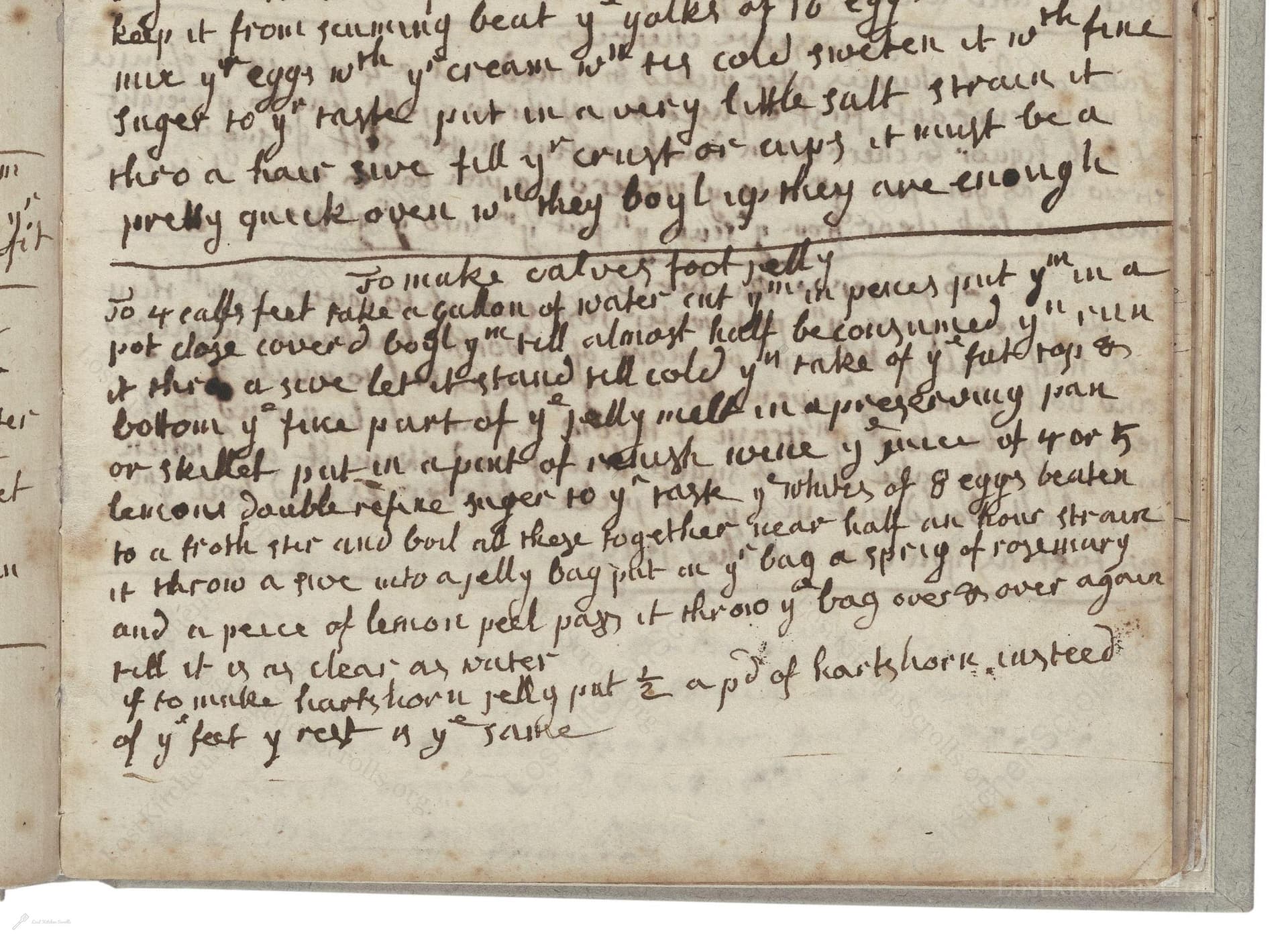To Make Calves Foot Jelly
From the treasured pages of Mrs. Knight's receipt book
Written by Mrs. Knight

To Make Calves Foot Jelly
"to 4 calfs feet take a gallon of water put ym in a pot close coverd boil ym till almost half be consumed yn strain it thro a seve let it stand till cold yn take of ye fat top & botom ye fine part of ye jelly melt in a preserving pan or skillet put in a pd of lemons double refine suger to ye tast ye whites of 8 eggs beaten put these together near half an hour strain it throw a five into a jelly bag put in ye bag a sprig of rosemary and a peece of lemon peele it must run till it is as clear as water if you want to make hartshorn jelly put in 1/2 a pd of hartshorn instead of ye feet ye rest is ye same"
Note on the Original Text
This eighteenth-century recipe is written as a continuous block, typical of the era, with minimal punctuation and abundant abbreviations (e.g., 'yn' for 'then', 'ye' for 'the', 'pd' for 'pound'). Measurements are imprecise and dependent on the cook's experience; ingredients like sugar are adjusted 'to your taste.' The language is direct, reflecting an oral transmission with spelling variants (e.g. 'ym', 'throw', 'seve') and no step numbers. Such presentation expects the reader to be versed in prevailing kitchen techniques.

Title
Mrs. Knight's receipt book (1740)
You can also click the book image above to peruse the original tome
Writer
Mrs. Knight
Era
1740
Publisher
Unknown
Background
Step into the refined kitchens of 18th-century England with Mrs. Knight’s culinary collection, where time-honored recipes, hearty roasts, and elegant pastries await the enterprising cook.
Kindly made available by
Folger Shakespeare Library
Mrs. Knight's recipe, penned around 1740, emerges from a period when jellies were both a culinary marvel and a symbol of domestic skill. Calves' foot jelly was both a delicacy and restorative food, valued for its clarity and daintiness on the table. Such recipes were frequently shared among the gentry and middling classes in manuscript collections, reflecting both the rise of refined sugar and the art of clarification in British kitchens.

The original recipe would have been made using a large iron or copper pot over an open fire, a close-fitting lid, and a skimming ladle to remove fat. Straining was done through a coarse sieve and, finally, through a jelly bag made of fine cloth (often flannel or muslin). Egg whites were beaten by hand with a whisk, and cooks would rely on preserving pans (shallow, wide-mouthed pans) for delicate simmering.
Prep Time
15 mins
Cook Time
6 hrs
Servings
10
We've done our best to adapt this historical recipe for modern kitchens, but some details may still need refinement. We warmly welcome feedback from fellow cooks and culinary historians — your insights support the entire community!
Ingredients
- 4 calves' feet (approximately 4.5 lbs) or 8 oz hartshorn shavings (as substitute)
- 4 quarts (1 gallon) water
- 14–18 oz double-refined sugar (or modern white cane sugar)
- 3–4 lemons (zest and juice; about 7–8 fl oz juice in total)
- 8 egg whites
- 1 sprig fresh rosemary
- 1 strip lemon peel
Instructions
- To prepare calves' foot jelly as Mrs.
- Knight might have in 1740, begin by placing 4 calves' feet (about 4.5 lbs) in a large pot with 4 quarts (1 gallon) of water.
- Cover and gently simmer for several hours until the liquid is reduced by nearly half.
- Strain through a sieve and allow to cool, then remove the fat from both the top and bottom, keeping only the clear jelly.
- Re-melt this jelly in a pan.
- Flavor with about 14–18 oz of sugar (adjust to taste) and the zest and juice from 3–4 lemons.
- Beat the whites of 8 eggs and add them to the mixture.
- Simmer gently for about 30 minutes, stirring, then strain through a fine sieve and finally through a jelly bag, adding a sprig of rosemary and a piece of lemon peel to the bag.
- Let it filter until the jelly is as clear as water.
- For a hartshorn version, substitute 8 oz of hartshorn shavings for the calves' feet, following the same steps.
Estimated Calories
220 per serving
Cooking Estimates
It takes a few hours to simmer the calves' feet, plus cooling and straining, so total cooking time is about 6 hours. Preparation before cooking is simple and takes about 15 minutes. This recipe makes about 10 servings. Each serving is estimated to have around 220 calories, mostly from the sugar and gelatin.
As noted above, we have made our best effort to translate and adapt this historical recipe for modern kitchens, taking into account ingredients nowadays, cooking techniques, measurements, and so on. However, historical recipes often contain assumptions that require interpretation.
We'd love for anyone to help improve these adaptations. Community contributions are highly welcome. If you have suggestions, corrections, or cooking tips based on your experience with this recipe, please share them below.
Join the Discussion
Rate This Recipe
Dietary Preference
Main Ingredients
Culinary Technique
Occasions

Den Bockfisch In Einer Fleisch Suppen Zu Kochen
This recipe hails from a German manuscript cookbook compiled in 1696, a time whe...

Die Grieß Nudlen Zumachen
This recipe comes from a rather mysterious manuscript cookbook, penned anonymous...

Ein Boudain
This recipe comes from an anonymous German-language manuscript cookbook from 169...

Ein Gesaltzen Citroni
This recipe, dating from 1696, comes from an extensive anonymous German cookbook...
Browse our complete collection of time-honored recipes



